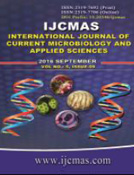


 National Academy of Agricultural Sciences (NAAS)
National Academy of Agricultural Sciences (NAAS)

|
PRINT ISSN : 2319-7692
Online ISSN : 2319-7706 Issues : 12 per year Publisher : Excellent Publishers Email : editorijcmas@gmail.com / submit@ijcmas.com Editor-in-chief: Dr.M.Prakash Index Copernicus ICV 2018: 95.39 NAAS RATING 2020: 5.38 |
A field experiment was conducted during 2007-08 (spring planting) at Agricultural farm of G.F. College, Shahjahanpur U.P. to study the effect of soil applied (0, 10, 20, 40 and 60 kg/ha) rice bran alongwith pre-sowing soaking of setts in 0.03% pyridoxine solution in ten sugarcane (Saccharum officinarum L.) (CoS 8436, CoS 95255, CoS 96268, CoSe 98231, CoSe 01235, CoS 01424, CoSe 95422, UP 097, CoSe 92423 and CoS 96275) cultivars in 4 x 2.5m plots each treatment replicated thrice in a factorial randomised block design. The soil was sandy loam, pH 7.10, E.C. 0.30 dS/m, Organic carbon 0.25%, available N 150 kg/ha. available P 10.20 kg/ha and available K 120kg/ha. A uniform basal dose of 150 kg N, 60kg P and 80 kg K/ha was applied to each bed before sowing. Nitrogen was given in (1/3 + 1/3 + 1/3) split doses as top dressing.Urea, monocalcium single super phosphate and muriate of potash were used as perspective sources of NPK. Third leaf was selected for the biochemical assays for fresh tissue material at pre-monsoon (120 DAP), post-monsoon (210 DAP), early ripenning (270 DAP), late ripenning (330 DAP) and at maturity (360 DAP) of the crop. The seed rate was (90 x 45cm) row to plant spacing. Weeding was done when required during the course of growth of plants. Standard agronomical practices were followed of the crop. The crop was sown on 24 Feb 2007 and harvested for early varieties on 20 January 2008 and 1 March 2008 for late varieties (DAP = Days after planting). Authentic seeds of sugarcane (Saccharum officinarum L.) varieties were obtained from Division of Sugarcane Breeding, U.P. Council of Sugarcane Research, Shahjahanpur. U.P. A significant increase in leaf starch content was noted as a result of soil applied rice bran as well as 0.03% pyridoxine soaking upto post monsoon (210 days) stage. The later two final stages showed a reverse trend as compared to control. CoSe 92423 showing mostly highest values for leaf starch content at all growth stages as compared to other cultivars showing a high source potential. As far as the interaction effect was concerned 0.03% pyridoxine soaking x CoSe 92423 gave significantly highest value upto post monsoon (210 days) stage and lowest value in the later final stages followed by the interaction 40 kg/ha soil-applied rice bran x CoSe 92423. The lower values in the last two stages shows conversion of carbohydrates into sugars for the storage. There was an increase in the level of amylase content significantly upto maturity stage. The impact of 0.03% pyridoxine sett soaking was maximum for this trait followed by 40kg/ha soil applied rice bran foliar biochemical analysis. CoSe 92423 responded most and gave maximum amylase activity at all stages of growth compared to other cultivars seems to be linked directly with sucrose accumulation in the cane.
 |
 |
 |
 |
 |